![]()
![]()
![]()
Use LEFT and RIGHT arrow keys to navigate between flashcards;
Use UP and DOWN arrow keys to flip the card;
H to show hint;
A reads text to speech;
185 Cards in this Set
- Front
- Back
|
Information Technology (IT) |
Information technology (IT) is the technology used to create, maintain, and make information available. |
|
|
Role of IT in an organization |
IT provides the information backbone of practically any organization. Responds to the practical needs of the organization, including reliable and secure solutions that are appropriately maintained, updated, and replaced |
|
|
IT as a System |
IT as a system includes the hardware, the software, the networking elements (maintained by IT professionals), and the people who use them. |
|
|
IT Functions |
User Support Data & Information Mgmt Networks Systems Integration |
|
|
Core Components of IT Hardware: Hard Disk |
A disk on which information is stored in the computer even when it is not connected to a power supply |
|
|
Core Components of IT Hardware: Monitor |
An output device that displays information in pictorial form, allowing the user to interact with the computer interface and open programs typically using a keyboard and mouse |
|
|
Core Components of IT Hardware: Motherboard |
One of the most essential parts of a computer system that holds many of the crucial components, including connectors for input and output devices |
|
|
Core Components of IT Hardware: CPU (Central Processing Unit) |
A control center that converts data input to information output. This is a highly complex, extensive set of electronic circuitry that executes stored program instructions |
|
|
Core Components of IT Hardware: RAM (Random Access Memory) |
The memory within the computer that holds the running programs and data when the computer is in use. Data can be read and written quickly in any order |
|
|
Core Components of IT Hardware: Other - Network Cables |
These cables connect and transfer data and information between computers |
|
|
Core Components of IT Hardware: Other - Wi-Fi Routers |
Wi-Fi routers transmit, receive, and decode information sent using radio waves |
|
|
Core Components of IT Hardware: Other - Laser Printers |
These printers use a laser to form a pattern of electrostatically charged dots on a light-sensitive drum, which attracts toner (or dry ink powder). The toner is transferred to a paper and is fixed by a heating process |
|
|
Core Components of IT Software: Software Development |
If an organization does not use third-party products to support business operations, it must develop software systems internally |
|
|
Core Components of IT Software: Business Analysis |
Organizations must constantly investigate, assess, and plan for new or replacement systems provided by vendors or developed internally |
|
|
Core Components of IT Software: Security |
Security concerns go beyond the technological features themselves and include the users and internal procedures. Organizations aim to put secure systems in place to identify threats and prevent incidents that compromise the organization's data or disrupt the business |
|
|
Web Development |
The IT function is to maintain the infrastructure that supports a website, whether on the internet, intranet, or extranet |
|
|
Business Intelligence |
Systems and personnel supporting data analytics use the organization's data to examine its past performance, identify the reasons behind past and current issues, and forecast future performance |
|
|
Project Management |
Organizations need to ensure that projects execute in a manageable fashion, maintain scope, and ensure optimal use of resources |
|
|
Outsourcing Services |
Smaller organizations cannot always employ a full range of IT professionals to support their systems. Instead, consultants are frequently brought in for technical support |
|
|
5 Most Commonly Recognized Computing Disciplines |
Computer Engineering Computer Science Software Engineering Information Systems Information Technology |
|
|
Computer Engineering |
The design of hardware systems and the software that makes them work |
|
|
Computer Science |
The design and implementation of software with an emphasis on developing effective ways to solve computing problems and creating new ways to use computers. It encompasses a range of computing-related tasks such as robotics, artificial intelligence, augmented reality, and algorithms designed to solve problems |
|
|
Software Engineering |
The development and maintenance of reliable and efficient software systems |
|
|
Information Systems |
Collections of data and information used to support decision-making in organizations. Systems that generate, process, and distribute information and support organizational communication and collaboration, their design, and their implementation |
|
|
History of IT: 1948 |
Manchester Mark 1 was one of the first ever stored-program computers. Developed at Victoria University of Manchester, operational June 1948, work on the program started August 1948, initial version operational April 1949. It's first ever computer program was written to search for Mersenne primes and ran for 9 hours straight |
|
|
History of IT: 1954 |
IBM sold 450 of its first mass-produced computer in one year. The Model 650 used magnetic data storage, was popular in universities. In 1956 direct keyboard input replaced punch cards and paper tape input |
|
|
History of IT: 1958 |
First large-scale computer communications. Network SAGE connected 23 computer sites in the US and Canada. The system was used to detect incoming Soviet bombers and direct interceptor aircraft to destroy them |
|
|
History of IT: 1960 |
The DEC PDP-1 computer systems retailed for approx $120,000 and required only one operator. It's large scope intrigued early hackers at MIT who wrote the first computer video game: Spacewar! and programs to play music as well. More than 50 PDP-1 computer systems were sold |
|
|
History of IT: 1968 |
Data General introduces the Nova minicomputer with 32kb memory, selling for $9,900. The Nova computers were popular throughout the 70s and influenced many later systems |
|
|
History of IT: 1971 |
Intel introduces the first microprocessor, the Intel 4004, which could perform up to 90,000 operations per second. The first laser printer introduced by Xerox launching a new era in printing |
|
|
History of IT: 1976 |
Intel introduces the 8080 microprocessor which could address a total of 64 kilobytes. Steve Wozniak creates the first Apple 1 with friend Steve Jobs. With an order for 50 assembled systems they start Apple Computer Inc |
|
|
History of IT: 1977 |
Apple II sold with keyboard, case, manual game paddles and cassette tape containing the game Breakout |
|
|
History of IT: 1979 |
Atari launches Model 400 and 800 computers using the marketing slogan of "Computers for People" |
|
|
History of IT: 1981 |
- MS-DOS, the Microsoft operating system, became the most licensed OS - Sony introduces the 3.5 inch floppy drive and diskettes, which became the microflora standard for portable storage - IBM launches the IBM PC with Intel 8088 microprocessor and Microsoft's MS-DOS operating system |
|
|
History of IT: 1982-1983 |
- Compaq introduces the first computer to use the new 80386 chip, a 32-bit microprocessor with 4 million operations per second and 4kb of memory - CD-ROMs able to hold 550MB of pre-recorded data are developed by Philips - Microsoft announces Microsoft Word and by 1989 it became a global word processing standard |
|
|
History of IT: 1984 |
- Apple launches the Macintosh, the first successful mouse-driven computer with a graphical user interface and a 68000 microprocessor - Compaq Computer Corporation introduces the first 100% compatible computer, the Compaq portable that can run the same software as the IBM PC |
|
|
History of IT: 1990 |
- Tim Berners-Lee invents the World Wide Web at CERN in Switzerland. The web is made publicly available on 6 August 1991 - Microsoft delivers Windows 3.0 providing the ability to run multiple programs simultaneously on the Intel 80386 chip |
|
|
History of IT: 1992 |
JPEG (Joint Photographic Expert Group) creates a set of standards for digital images. JPEG is now one of the most widely used photo formats |
|
|
History of IT: 1993 |
Mosaic, the first browser for the web, is created. Online advertisements on the web begin. By the end of the decade, over 360 million users are active on the web |
|
|
History of IT: 1994 |
- CompactFlash memory storage is introduced by SanDisk and becomes popular - Sony releases the Playstation console and becomes a dominant player in the home gaming market |
|
|
History of IT: 1997 |
IBM's Deep Blue chess computer defeats world chess champion Gary Kasparov. Text messaging becomes the norm after commencing in 1992 accelerated by the introduction of the Nokia 6110, the Blackberry, and other mobile phones |
|
|
History of IT: 2000 |
- First camera phones are introduced - USB flash drives are introduced for data storage and backing up as well as transferring files between devices - Honda introduces ASIMO (Advanced Step in Innovative Mobility) humanoid robot |
|
|
History of IT: 2001 |
iTunes released for the Mac operating system only as a media player and management tool. By 2013, over 25 billion songs had been downloaded from the iTunes store |
|
|
History of IT: 2002 |
Microsoft launches the Xbox based on Microsoft's Direct X graphics technology |
|
|
History of IT: 2006 |
- The verb "to google" added to the Oxford English and Merriam-Webster dictionaries - Amazon Web Services launches cloud based services allowing users to rent virtual time on the cloud to scale server capacity. Similar services like Google Drive follow |
|
|
History of IT: 2007 |
Amazon Kindle is released. Apple iPhone is released with apps available from the Apple store. Google's Android mobile platform followed |
|
|
History of IT: 2010 |
- Apple iPad is released with nine-inch screen, without a phone. Adapted for thousands of different applications - Apple Retina display for MacBooks offers screen resolution up to 400 pixels per inch - IBM Watson beats former Jeopardy champion contestant, and in 2011 Watson beats two former champions |
|
|
History of IT: 2011 |
Adobe Creative Cloud is announced as a subscription model of distribution for its major software products |
|
|
History of IT: 2012 |
Raspberry Pi, a small single board computer, is released as a tool to promote science education weighing 45 grams and initially sold for $25-35 USD |
|
|
History of IT: 2013 |
Microsoft Office 365 is announced offering Microsoft's product suite online for a subscription |
|
|
History of IT: 2014 |
Apple Pay mobile payment system is introduced into Apple's product ecosystem |
|
|
History of IT: 2015 |
Ape watch is released incorporating Apple iOS operating system with sensors for environment and health monitoring |
|
|
History of IT: 2019 |
Occlusion releases the Oculus Rift S with a 2560 x 1440 LCD and one more camera facing upward |
|
|
5 Key IT Roles |
IT Administrator IT Architect IT Engineer Help Desk Professional DevOps Professional |
|
|
System Administrator |
Responsible for providing technical support for hardware and software issues end users encounter, such as log-in issues. Requires an associate's degree or higher and a basic understanding of network vulnerabilities and security issues. The CompTIA Network+ and the CompTIA Security+ certifications demonstrate up-to-date knowledge and skills |
|
|
Network Administrator |
Responsible for designing, planning, setting up, and maintaining an organization’s network. Requires an associate's degree or higher, network troubleshooting experience, and effective problem-solving skills. The CompTIA A+, CompTIA Network+, or CompTIA Security+ certification demonstrates up-to-date knowledge and skills |
|
|
Database Administrator |
Responsible for installing and configuring databases. This position also fixes database errors and creates user accounts. This position requires a bachelor’s degree in computer science or computer engineering. The MySQL and Oracle Database certifications are examples of certifications that demonstrate up-to-date knowledge and skills |
|
|
Security Administrator |
Responsible for installing, administering, and troubleshooting network security issues. This position requires an associate’s or bachelor’s degree in computer science, cybersecurity, or a related field. It also requires a deep understanding of IT infrastructures, including protocols, operating systems, and networks. CompTIA Security+ is a certification that demonstrates up-to-date knowledge and skills |
|
|
Web Administrator |
Responsible for troubleshooting error messages employees encounter when attempting to access their organization’s website. Responsible for tracking, compiling, and analyzing website usage data. Reports security breaches to appropriate personnel. This position requires an associate’s or bachelor’s degree in computer science, information technology, or a similar field. However, with the rise in nontraditional education, employers are hiring self-taught programmers as long as they have a solid web portfolio |
|
|
Cloud Architect |
Responsible for overseeing a company’s cloud computing systems. This position requires a bachelor’s degree in computer science, computer engineering, information technology, or another relevant field. Strong understanding of operating systems such as LINUX, UNIX, and Windows is required. The CompTIA Cloud Essentials certification demonstrates up-to-date knowledge and skills |
|
|
Network Architect |
Responsible for designing networks and monitoring traffic. Responsible for installing routers and modems and upgrading hardware and software that are essential for the network to function properly. A bachelor’s degree in computer science, information systems, information technology, or a related IT field is recommended. CompTIA A+, VMware Certified Professional, and other industry certifications can help an individual qualify |
|
|
Automation Architect |
Responsible for modernizing business processes and developing reasons or rationales for or against a process being automated. This position prefers a bachelor’s degree with accompanying hands-on experience of application design and architect experience |
|
|
Cybersecurity Architect |
Responsible for designing, building, testing, and implementing security systems within an organization’s information technology network. Requires a thorough understanding of an organization’s IT systems to anticipate possible network security breaches. An associate’s or bachelor’s degree in IT, computer science, or a related field is recommended. Advanced IT security certifications such as CompTIA Security+ may be advantageous for demonstrating up-to-date knowledge and skills |
|
|
Machine Learning Engineer |
Responsible for allowing an organization to take full control of its data. Application developers and computer programmers with data analytical skills can transition to become machine learning engineers. Experience in Python, R, or Java with a background in machine learning frameworks is required |
|
|
Software Engineer |
Software engineers design and develop software that makes hardware and software systems work, including operating systems, database systems, and embedded systems. They need to understand hardware and software. Software engineers work with clients and colleagues to understand requirements and perform detailed technical work. Software engineers typically work in IT, electronics, or telecommunication companies in roles such as application programmers, software developers, and software architects. These jobs require attention to detail, analytical and logical thinking skills, and teamwork. Proficiency in working on complex software projects, accompanied by a bachelor’s degree in math, computer science, software engineering, or information technology, is recommended |
|
|
Network Engineer |
Hardware engineers, network designers, and network engineers set up, configure, maintain, and upgrade systems where data resides and that support the exchange of information, including communication systems and networks. Network engineers ensure that the security of data and information is appropriate and that companies have processes and procedures in place to enable business operations to continue in the event of a disaster. Anyone working in the IT department needs to have a deep understanding of networks and systems. However, the network engineer should have the ability to communicate, plan, analyze, and solve problems effectively |
|
|
Cloud Engineer |
Cloud software engineers, cloud security engineers, cloud system engineers, and cloud network engineers use their technical and analytical skills to help companies identify opportunities for migrating a part or all of their infrastructure to the cloud, supporting the more efficient use of resources and improving IT operations. These individuals design and set up automation, cloud storage, data centers, virtual servers, and web services with an emphasis on a particular solution’s cost, benefits to users, and security of data processing |
|
|
Analysts: Technical Support |
The technical support specialist supports, monitors, and maintains workplace technology and responds to user requests for help. Titles for technical support in an organization include helpdesk specialist and IT support specialist. These roles need a wide range of IT knowledge, problem-solving skills, and patience to help users benefit from the available technology. Most IT professionals start their IT career in a technical support role. No higher education is required for entry-level positions. However, individuals who possess a bachelor’s degree in computer science, software engineering, information technology, or a related field are qualified |
|
|
Systems Analyst |
Systems analysts, product specialists, systems engineers, solutions specialists, and technical designers investigate business problems and create information systems to provide solutions. These jobs require both business and technical knowledge and rely on effective communication to understand clients’ requirements. A bachelor’s degree in a computer-related field is recommended. As an organization's reliance on IT continues to expand, reliance on systems analysts will continue to grow |
|
|
Data Analyst |
Organizations gather data from customers and internal operations to identify opportunities to improve business operations. Data analysts use statistical and other quantitative methods to gain insights that support the organization’s decision-making. Data scientists, data analysts, and statisticians use their analytical expertise and presentation skills to tell the stories hidden in the data |
|
|
Security Analyst |
The security analyst is responsible for monitoring an organization's network for security breaches. The role of this specific job will continue to grow as organizations continue to encounter network attacks. Most security analysts possess at least a bachelor’s degree in computer science, programming, or a related field |
|
|
Cybersecurity Specialist |
The security analyst is responsible for monitoring an organization's network for security breaches. The role of this specific job will continue to grow as organizations continue to encounter network attacks. Most security analysts possess at least a bachelor’s degree in computer science, programming, or a related field |
|
|
Technical Consultant |
Technical consultants, IT consultants, or IT specialists provide technical expertise by developing and implementing IT systems for external clients. Skills that are of particular importance for these roles include communication, presentation, technical and business understanding, project management, and teamwork. Consultants may work for themselves or for an organization providing third-party IT services |
|
|
Project Manager |
The project manager organizes people, time, and other resources to make sure projects meet requirements and are completed on time and within budget. To successfully manage projects from start to finish, project managers need good organization, problem-solving, and communication skills, as well as an ability to stay calm and focused under pressure. A bachelor’s degree in business administration or a related discipline is recommended |
|
|
Web developer |
The web developer builds and maintains websites and their infrastructure. Web developers are also called web designers, web producers, and internet engineers. Their tasks range from technical to creative and include multimedia elements and the user interface. Web developers need to understand client-side, server-side, and database web technologies. In addition, web developers must have sharp analytical thinking and problem-solving skills and creativity. Generally, web developers may do some work with the interface, but developers are typically more involved with the infrastructure, such as installing web services, configuring authentication (if any), and managing database connections |
|
|
Software Tester |
The software tester is responsible for creating, documenting, and executing manually created test plans and procedures relating to system anomalies. Software testers apply attention to detail, creativity, and analytical and investigative thinking skills to prepare testing scenarios to discover issues in a system. Test analysts, software quality assurance testers, and other software testing roles try to anticipate all the ways an application or system might be used and how it could fail. They then communicate their findings to the project team to identify solutions that will mitigate the issues. No formal education is required. Experience in various programming languages is recommended |
|
|
Technical Sales |
IT professionals in the role of sales or account managers identify and help clients adopt IT services or technologies. These positions require both technical knowledge and the ability to communicate solutions or services to an organization. Product knowledge, negotiation skills, interpersonal skills, and business awareness are some of the key attributes of successful IT professionals in the technical sales domain |
|
|
Data Pyramid |
Concept that visualizes the data-information-knowledge-wisdom hierarchy |
|
|
D-I-K-W |
- Data - Raw facts or observations - Information - Collection of processed data from a variety of sources, key term associated with it is MEANING - Knowledge - Dynamic combination of experience, values, contextual information, expert insight, and grounded intuition that provides an environment and framework for evaluating and incorporating new experiences and information, key term associated with it is CONTEXT - Wisdom - Knowing the right thing to do |
|
|
Connectedness Wisdom |
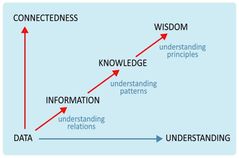
|
|
|
Data Pyramid |
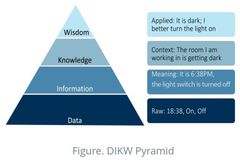
|
|
|
Data Pyramid Flipped |
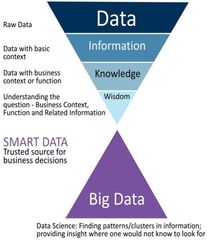
|
|
|
Structured Data |
Coded in a way that makes it easy to convert into a form usable for analysis. Examples of structured data include contact information such as first name, last name, email address, and phone number. In addition, quantitative fields like date of birth, date of transaction, and the amount received or amount due are forms of structured data |
|
|
Unstructured Data |
Data that is more complex and possibly stored in a format that is not easily decoded. Unstructured data takes more time to parse through to retrieve the essential information. Examples of unstructured data include data stored in text or video format, comments on a web page, text messages, and videos of presentations or conferences |
|
|
Difference between Structured and Unstructured Data |
The form in which it is stored. While structured data is coded in an easily usable form, unstructured data requires a greater effort to extract |
|
|
Big Data |
A large collection of data that is incapable of being processed by previous generations of analytical tools. The Big Data market is estimated to grow 45% annually for the foreseeable future |
|
|
Data Architecture |
The infrastructure used to manage data in an organization (in-house or in the cloud) |
|
|
Data Hygiene |
Refers to the processes of ensuring the cleanliness of data (i.e., that the data is relatively error-free) |
|
|
Dirty Data |
Can be caused by things such as duplicate records, incomplete or outdated data, and mistakes introduced as data is entered, stored, and managed |
|
|
Data Scrubbing |
The process of amending or removing data in a database that is incorrect, incomplete, improperly formatted, or duplicated. Typically, the process involves updating, standardizing, and de-duplicating records to create a single view of the data, even if it is stored in multiple systems |
|
|
Dirty Data Table |

|
|
|
Quality Data |
Typically defined as data that is precise, valid, reliable, timely, and complete. Different organizations will prioritize these attributes according to their needs. An organization might also include additional attributes |
|
|
Precision in Data |
Describes how precise the data is in the context of its intended use. Data collected in healthcare, for example, must be more precise than that of other industries |
|
|
Computer System |
System that consists of hardware and software components that work together to store, retrieve, and process data |
|
|
The Functions of a Computer System |
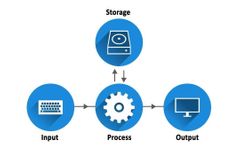
The system divides the work into three parts: (1) a requirement from the environment or input, (2) a computation based on the requirement or process, and (3) a provision for the environment or output. In addition, it uses storage for the input and output elements, as well as for keeping the results of the calculations during the processing |
|
|
People |
The most important element of a computer system is its users, sometimes called liveware |
|
|
Core Anatomy of a Computer |
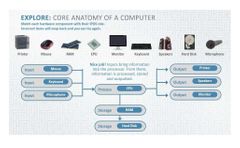
|
|
|
Computer Hardware |
Provides the physical elements that support each function of the IPO model |
|
|
Computer Software |
A collection of instructions that enable a user to interact with a computer to perform tasks |
|
|
Components of a Computer system |
The electronic and mechanical parts of a computer system are known as hardware, the data and the computer programs are referred to as software, and the components that share software and data between elements of a computer system (both hardware and software components) are known as middleware |
|
|
Networks |
Systems of hardware and software components that connect two or more devices for the purpose of sharing data and information |
|
|
2 Common types of Networks |
Local area networks (LANs) and wide area networks (WANs). LANs span a single home, school, or small office building and provide a connection for devices that are within the same network. WANs reach across cities, states, or even across the world. The internet is the world’s largest public wide area network |
|
|
2 Types of Network Design |
Client-to-server and peer-to-peer. An example of a client-server implementation are servers on one side of the network running authentication to facilitate millions of users logging in and permitting access to specific resources based on parameters such as username, password, and system identifiers. In a peer-to-peer network, all devices tend to support the same functions. Access to resources is provided without the assistance of a server. File transfer protocol is an example of peer-to-peer implementation. Client-server networks are common across organizations and peer-to-peer networks are common in small offices and homes |
|
|
Physical Topology |
The actual layout of how systems are placed in the network |
|
|
Logical Topology |
This form of a topology indicates how the data actually flow and is extremely important when considering things like load balancing normal traffic, network backups, and replication of data |
|
|
Most Common Network Topology Layouts |
Bus Star Ring Mesh |
|
|
Protocols |
Languages supporting data exchange between computers are referred to as protocols. Different networks may support different protocols. The most popular protocol is TCP/IP and is commonly found on the internet and in home networks |
|
|
Special Purpose Computer Systems |
Includes network routers, access points, and switches |
|
|
Hardware, Software, and Network Components |
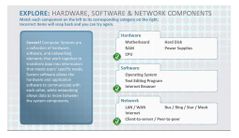
|
|
|
ENIAC (Electronic Numerical Integrator and Calculator) |
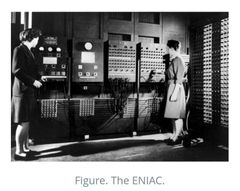
Built between 1943 and 1945—the first large-scale computer to run at electronic speed without being slowed by any mechanical parts. For a decade, until a 1955 lightning strike, ENIAC may have run more calculations than all mankind had done up to that point |
|
|
History of the Computer: Abacus |

|
|
|
History of the Computer: Leibniz Machine |
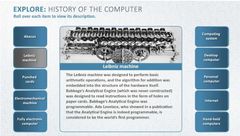
|
|
|
History of the Computer: Punched Cards |
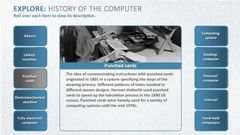
|
|
|
History of the Computer: Electromechanical Machine |
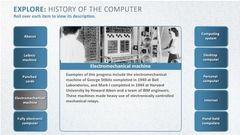
|
|
|
History of the Computer: Fully Electronic Computer |
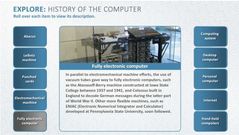
|
|
|
History of the Computer: Computing System |
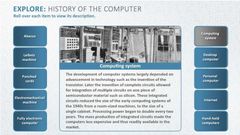
|
|
|
History of the Computer: Desktop Computer |

|
|
|
History of the Computer: Personal Computer |

|
|
|
History of the Computer: Internet |
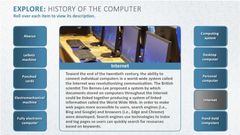
|
|
|
History of the Computer: Hand-Held Computers |
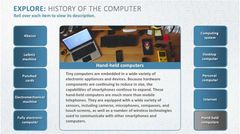
|
|
|
Computer History Timeline: 1st Generation |
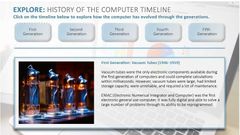
|
|
|
Computer History Timeline: 2nd Generation |
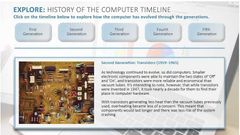
|
|
|
Computer History Timeline: 3rd Generation |

|
|
|
Computer History Timeline: 4th Generation |
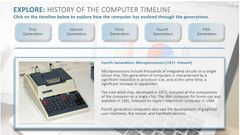
|
|
|
Computer History Timeline: 5th Generation |

|
|
|
Quantum Computing |
The study of a non-classical model of computation. It is said to be more efficient than modern computing through the use of quantum tunneling. Quantum computers are expected to reduce power consumption from 100 to 1000 times and will allow computing to surpass any and all limits that traditional computing has se |
|
|
Nanotechnology |
Nanotechnology and molecular manufacturing involves the use of nanoscale (extremely small) tools and nonbiological processes to build structures, devices, and systems at the molecular level. It is a technology based on the ability to build structures to complex, atomic specifications by means of mechanosynthesis, or reaction outcomes determined by the use of mechanical constraints. Nanotechnology is a very diverse field, which is having a bigger and bigger impact on the world. It has applications in medicine, cars, spacecraft, food, electronics, and materials science just to name a few |
|
|
Von Neumann Computer Architecture |
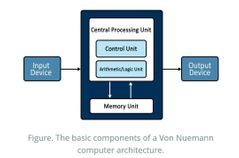
|
|
|
RAM |
Stores ephemeral programs and data in use temporarily for quick access |
|
|
CD-ROM |
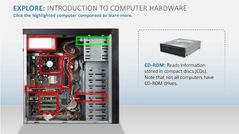
|
|
|
Hard Drive |

|
|
|
Power Supply |
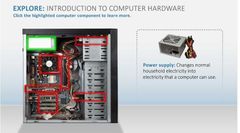
|
|
|
CPU |

|
|
|
Expansion Card |
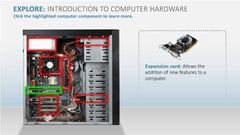
|
|
|
RAM |

|
|
|
Expansion Slot |
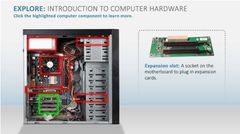
|
|
|
Motherboard |
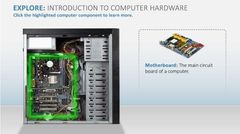
|
|
|
CPU |
The electronic circuit responsible for executing computer program instructions |
|
|
Types of Registers |
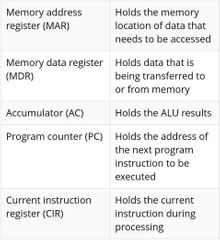
|
|
|
3 Types of Bus Lines |
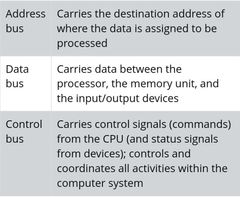
|
|
|
Units of Storage |
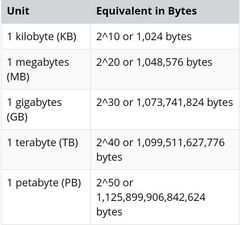
|
|
|
Device Types |
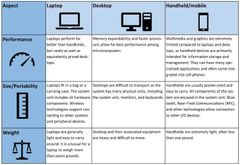
|
|
|
Networking |
Sharing information and resources through linked computer systems |
|
|
PAN |
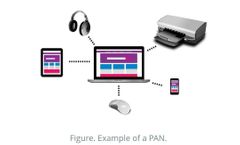
|
|
|
LAN |
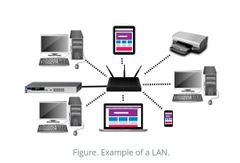
|
|
|
WAN |

|
|
|
3 Major Categories of Networks |
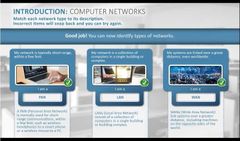
|
|
|
Client/Server Model |
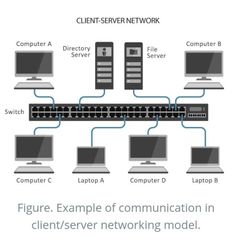
|
|
|
Peer-to-Peer (P2P) |
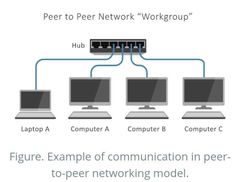
|
|
|
Network |
A collection of two or more connected devices that can communicate with one another |
|
|
Transmission Medium |
A component that carries data from one network device to another - the 2 types are wired and wireless |
|
|
Twisted Pair Cables |
Unshielded (UTP) or shielded (STP). STP are more expensive because they are 2 separately insulated copper wires (protects from neighboring unshielded cables and electromagnetic interference from fluorescent lights. Twisted pairs have various bandwidth capacities and a maximum segment length of 100 meters (328 feet) |
|
|
Cable Category and Bandwidth |
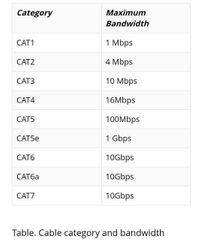
|
|
|
Network Elements: Internet |
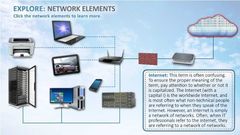
|
|
|
Network Elements: Modem |
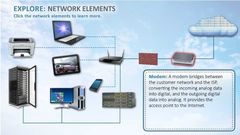
|
|
|
Network Elements: Firewall |

|
|
|
Network Elements: Router |

|
|
|
Network Elements: Smartphone |
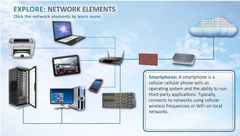
|
|
|
Network Elements: Switch |
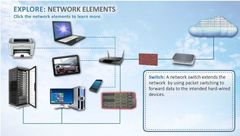
|
|
|
Network Elements: Laptop |
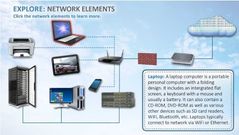
|
|
|
Network Elements: Tablet Computer |
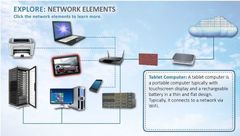
|
|
|
Network Elements: Desktop Computer |
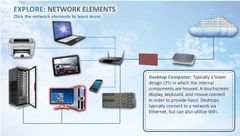
|
|
|
Network Elements: Printer |

|
|
|
Network Elements: Server |
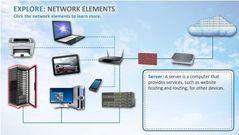
|
|
|
World Wide Web |
Created by Tim Berners-Lee in the late 80s. Composed of a hypertext document format for embedding hyperlinks to other documents, a protocol for transferring hypertext over the network, and a server process that supplies hypertext pages upon request |
|
|
URL (Uniform Resource Locator) |
The URL includes the protocol, domain, and all subdomains, as well as the resource path ID and name of the document |
|
|
CIA Triangle in Network Security |
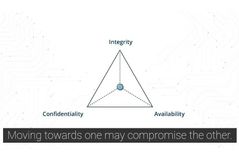
|
|
|
Threats to Network Security |

|
|
|
White-Hat Hacker Tests |

|
|
|
Software Hierarchy |
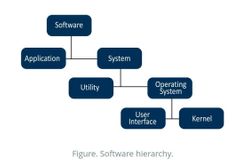
|
|
|
Application vs System Software |
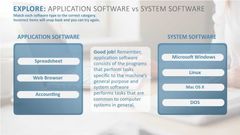
|
|
|
Paging |
A technique used by the memory manager that creates an illusion of additional space by rotating programs and data between the primary and secondary memory |
|
|
Virtual Memory |
The additional memory space created in secondary memory by paging |
|
|
Productivity and Collaboration Software |
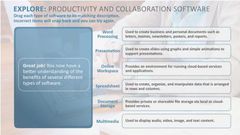
|
|
|
Compilers |
A compiler translates source code into machine language. A compiler checks source code for errors before translating it into object code. If the source code is found to have errors, the compiler specifies the errors. Errors must be resolved (also known as debugged) before the compiler can successfully recompile the source code. C, C++, C#, and Java programs need compilers to execute |
|
|
Interpreters |
Interpreters translate and execute source code one line at a time. If the interpreter finds an error, the process is terminated at the statement containing the error and displays an error message. The error must be resolved before the interpreter will continue to the next line. Interpreters convert instructions one statement at a time when the program is run. Perl and Python execute using interpreters |
|
|
Common High-Level Programming Languages |

|
|
|
Types of Data |
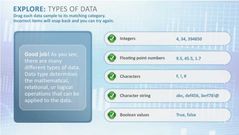
|
|
|
Flat-File Database |
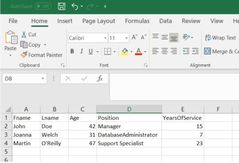
|
|
|
Hierarchical Database |
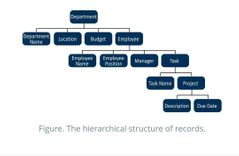
|
|
|
Relational Database |
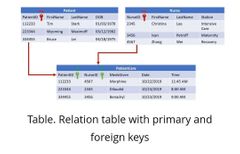
|
|
|
Database Operations: Selection Operation |
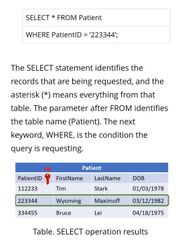
|
|
|
Database Operations: Union Operation |

|
|
|
Database Operations: Product Operation |
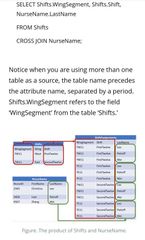
|
|
|
Database Operations: Join Operation |
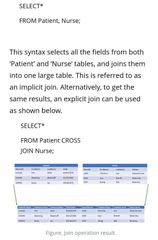
|

